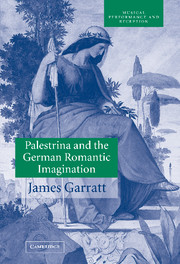Book contents
- Frontmatter
- Contents
- Acknowledgements
- List of abbreviations
- Introduction
- 1 Historicism in nineteenth-century art, aesthetics and culture
- 2 Romanticism and the problem of church music
- 3 The Protestant Palestrina revival
- 4 The Catholic Palestrina revival
- 5 Palestrina in the concert hall
- 6 Interpreting the secondary discourse of nineteenth-century music
- Notes
- Bibliography
- Index
5 - Palestrina in the concert hall
Published online by Cambridge University Press: 12 October 2009
- Frontmatter
- Contents
- Acknowledgements
- List of abbreviations
- Introduction
- 1 Historicism in nineteenth-century art, aesthetics and culture
- 2 Romanticism and the problem of church music
- 3 The Protestant Palestrina revival
- 4 The Catholic Palestrina revival
- 5 Palestrina in the concert hall
- 6 Interpreting the secondary discourse of nineteenth-century music
- Notes
- Bibliography
- Index
Summary
PALESTRINA IN SECULAR AND NON-LITURGICAL MUSIC
So far, the relation between the Palestrina revival and nineteenth-century composition has been discussed in terms of liturgical music, and to a lesser extent quasi-liturgical works intended for secular choral societies. The idealization of Palestrina had a much broader impact, being reflected in a wide range of vocal and instrumental genres. The forms that such relationships take, and the significances that they have for the works concerned, are extraordinarily diverse. In exploring these relationships and the interpretive problems that they create, this discussion focuses on works by four composers – Mendelssohn, Loewe, Liszt and Wagner – providing examples of how nineteenth-century compositions exploit the associations of Palestrina's music and language.
In secular and non-liturgical religious compositions, relationships to the language of Palestrina and to specific works by him are seldom problematic in terms of originality or historicism: in general, such relationships consist of small-scale references and rarely effect the stylistic orientation of the works concerned as totalities. As a consequence, the concern here is not – as before – with how composers were able to justify the cultivation of historical styles in the light of contemporary aesthetic norms, but with exploring the associative significance of such references. Although delineating the individual configurations of such relationships remains important, the central task must be to reconstruct what the content or essence of Palestrina's music was perceived to be in the nineteenth century,and thus to define the associations brought into play by the use or evocation of elements of his language.
- Type
- Chapter
- Information
- Palestrina and the German Romantic ImaginationInterpreting Historicism in Nineteenth-Century Music, pp. 214 - 240Publisher: Cambridge University PressPrint publication year: 2002

